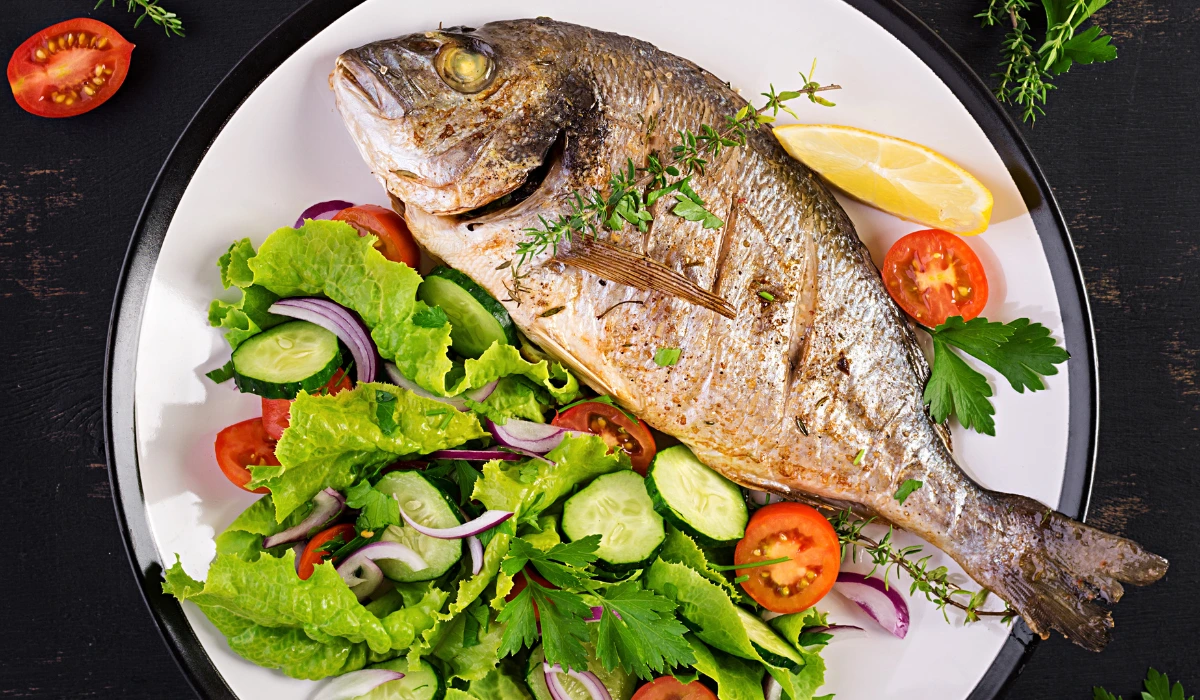
Introduction
Hibachi salmon is not just a dish; it’s an experience that brings the vibrant flavors of Japanese cuisine right into your home kitchen. This delightful meal, often served in Japanese steakhouses, combines the rich taste of salmon with a variety of sauces and seasonings, creating a satisfying and impressive dining experience.
In this comprehensive guide, we will explore everything you need to know about preparing hibachi salmon—from selecting the right ingredients to mastering cooking techniques. By the end, you’ll be ready to impress your family and friends with your culinary skills.
Hibachi cooking is a traditional Japanese method that emphasizes grilling food over high heat. The term “hibachi” translates to “fire bowl,” referring to the portable heating device originally used for cooking. Today, hibachi cooking is synonymous with the theatrical style of cooking seen in Japanese steakhouses, where chefs prepare meals in front of guests on a flat iron griddle.
What This Blog Covers
1. How to Set Up a Hibachi Grill
Step-by-step instructions on preparing your hibachi grill for the perfect cooking experience. Learn how to set up the grill, manage the heat, and maintain the right temperature for grilling.
2. Authentic Hibachi Cooking Techniques
Uncover the traditional Japanese grilling method, its cultural origins, and how to replicate the authentic hibachi experience at home.
3. Ingredient Selection
Learn how to choose the freshest salmon, seasonings, and ingredients that elevate the flavor of your dish.
4. Step-by-Step Recipes
Follow detailed, easy-to-understand recipes to cook restaurant-quality hibachi salmon in your own kitchen.
5. Creative Variations
Explore exciting twists on the classic recipe, including teriyaki, miso-glazed, and spicy hibachi salmon options.
6. Pairing and Presentation
Get inspired with side dish ideas, sauce pairings, and plating tips to complete your meal with style.
7. Cultural Insights and Hosting Tips
Understand how hibachi dining brings people together and learn how to host a memorable hibachi dinner party for friends and family.
Whether you’re a seasoned cook or just getting started, this blog offers valuable tips and techniques to make your hibachi salmon truly unforgettable.
Short Story: The Hibachi Journey
In the heart of a bustling city, there was a charming restaurant called “Sakura Grill,” renowned for its hibachi cooking. Among its regulars was Mia, a young woman who had recently moved to the city in search of adventure and connection. One evening, she decided to treat herself to dinner at Sakura Grill, drawn in by the enticing aroma of grilled salmon wafting through the door.
As Mia settled at the counter, she watched Chef Kenji, a master hibachi chef known for his dazzling performances. With a warm smile, he engaged diners with stories from his homeland while expertly grilling fresh salmon. The sizzle of fish meeting the hot grill filled the air, and Mia’s mouth watered as she observed Kenji’s skillful technique.
As he prepared her meal, Kenji shared his philosophy: cooking was not just about food; it was about creating memories and bringing people together. Intrigued by his passion, Mia struck up a conversation during a brief pause in his performance. They exchanged stories about their dreams and love for food, and Mia felt an instant connection.
When her hibachi salmon arrived—perfectly seared and garnished with sesame seeds—Mia savored every bite. Inspired by the experience, she asked Kenji if she could learn to cook like him. He welcomed her to join his upcoming cooking classes.
Over the next few weeks, Mia immersed herself in the art of hibachi cooking. Under Kenji’s guidance, she not only learned techniques but also discovered how food could forge connections. One evening, during a class showcase, she prepared her own hibachi salmon dish for friends and family.
As she grilled with confidence and flair, laughter and applause filled the room. In that moment, Mia realized that she had found her place in the city—not just as a cook but as part of a community united by food. The hibachi salmon experience had transformed her life, igniting her passion for cooking and helping her build lasting friendships.
Key Features of Hibachi Cooking
| Feature | Description |
|---|---|
| High Heat | Cooking at high temperatures ensures quick searing and locks in flavors. |
| Interactive Experience | Hibachi meals are typically prepared in front of diners, making it engaging and fun. |
| Fresh Ingredients | Fresh vegetables and proteins elevate the flavor and quality of the dish. |
Why We Recommend This Blog to Read
This blog is an excellent resource for anyone eager to elevate their cooking skills or explore the joy of Japanese cuisine. Here’s why we think you’ll love it:
- Comprehensive and Beginner-Friendly: Perfect for both novice cooks and seasoned chefs with its easy-to-follow instructions.
- Authentic and Versatile: Learn to recreate the smoky, rich flavors of hibachi salmon at home with recipes adaptable to your taste.
- Inspiring and Informative: Dive into the cultural roots of hibachi cooking while gaining practical tips and creative ideas.
- Engaging Storytelling: The personal anecdote of Mia’s journey adds warmth and inspiration to the culinary experience.
- Health-Conscious Approach: Highlights the nutritional benefits of salmon and encourages the use of fresh, high-quality ingredients.
Whether you’re planning a special dinner or looking to try something new, this blog has everything you need to make hibachi salmon a flavorful and memorable dish!
“Cooking hibachi salmon is not just about the ingredients; it’s about creating a moment where flavors dance and memories are made, turning every meal into a celebration.”
The Cultural Significance of Hibachi
Hibachi cooking has deep roots in Japanese culture. It is not just about preparing food; it’s about the experience of dining together. Traditionally, hibachi meals are enjoyed with family and friends, fostering a sense of community and connection. The performance aspect of hibachi—where chefs showcase their skills—adds an element of entertainment that makes dining out a memorable occasion.
How to Set Up a Hibachi Grill
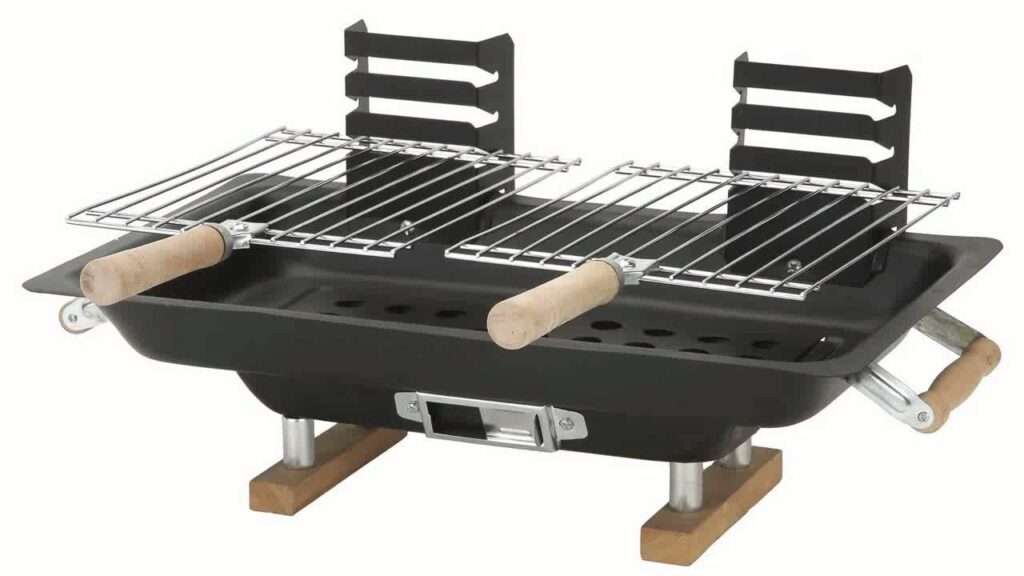
1. Prepare the Grill
- Clean the Grill: Ensure that the grill is clean from any previous cooking. Remove any old ash or food debris using a grill brush.
- Set Up the Grill Area: Place the hibachi grill on a flat, stable surface, preferably outside. Make sure it’s away from any flammable materials like paper towels, plastic, or cloth.
2. Add Charcoal (for Charcoal Hibachi)
- Fill the Grill: If you’re using a charcoal hibachi, fill the grill with lump charcoal or briquettes. For optimal heat, arrange the charcoal in a pyramid shape in the center of the grill.
- Light the Charcoal: Use a charcoal chimney starter or matches to light the charcoal. If you’re using a chimney starter, fill it with charcoal, place it in the grill, and light the bottom with paper or lighter cubes. Wait for the charcoal to glow orange and ashed over (this usually takes about 15-20 minutes).
- Spread the Charcoal: Once the charcoal is ready, use tongs to spread it evenly across the grill, creating a hot zone for searing and a cooler zone for indirect cooking.
3. Set Up the Gas (for Gas Hibachi)
- Connect the Gas Tank: If you’re using a gas hibachi, make sure the propane tank is securely connected to the grill. Check for leaks by turning on the gas and applying soapy water to the connections—if bubbles form, turn off the gas and fix the leak before proceeding.
- Ignite the Grill: Turn on the gas and use the ignition button or a match to light the burner. Adjust the flame to medium-high heat for cooking.
- Preheat the Grill: Let the grill preheat for about 10-15 minutes to reach the desired temperature (around 375°F to 400°F).
4. Set Up the Griddle Pan (Optional)
- If you’re using a flat griddle pan on your hibachi grill for more even heat distribution, place it on top of the grill grates once the grill is heated. Let it heat for about 5 minutes before cooking.
5. Prepare for Cooking
- Oil the Grill: Before cooking, lightly oil the grill grates or griddle with a high smoke-point oil (like vegetable oil or canola oil) to prevent sticking.
- Organize Your Cooking Area: Set up your cooking utensils (spatula, tongs, etc.) within easy reach. Have a heat-resistant plate or tray ready for cooked food and a separate plate for raw ingredients.
6. Adjust for Heat Zones
- Direct Heat Zone: Place the hot coals or set your gas burners to high heat for direct searing.
- Indirect Heat Zone: Move some of the coals to one side (for charcoal grills) or turn off one or more burners (for gas grills) to create a cooler area where you can move the fish to finish cooking without burning it.
7. Begin Cooking
- Once everything is preheated and ready, begin cooking your hibachi salmon or other ingredients. Use tongs to carefully handle the food and a spatula to flip it.
8. Clean Up
- After cooking, let the grill cool completely before cleaning it. Use a grill brush to clean the grates or griddle while still slightly warm, and empty the ashes from a charcoal grill.
Choosing the Right Salmon
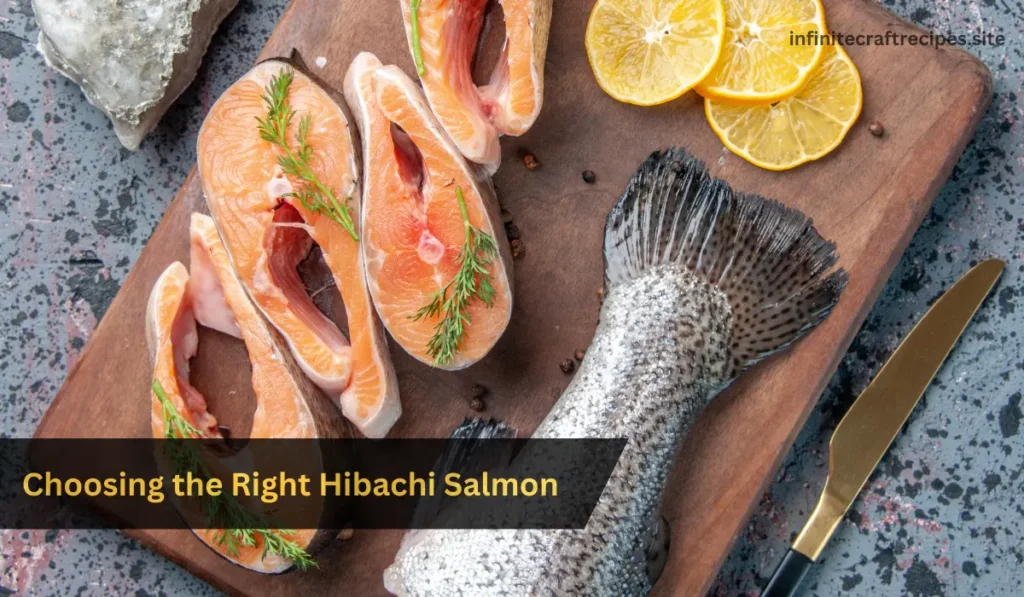
When it comes to hibachi salmon, selecting the right type of salmon is crucial for achieving the best flavor and texture. Here’s what you need to know:
Types of Salmon
| Type of Salmon | Flavor Profile | Texture | Best Use |
| Atlantic Salmon | Rich, buttery flavor | Tender | Grilling, baking |
| Sockeye Salmon | Strong, robust flavor | Firm | Grilling, broiling |
| Coho Salmon | Milder than sockeye | Medium-firm | Versatile cooking methods |
Fresh vs. Frozen Salmon
- Fresh Salmon: Always preferable when available; look for bright color and firm flesh.
- Frozen Salmon: If fresh isn’t an option, ensure it’s properly thawed before cooking to maintain texture.
Tips for Selecting Quality Salmon
- Look for Color: Fresh salmon should have a vibrant color—deep pink or orange without any dullness.
- Check for Smell: Fresh fish should have a clean smell; avoid any fishy odors.
- Feel the Flesh: The flesh should be firm to the touch and bounce back when pressed.
Essential Ingredients for Hibachi Salmon
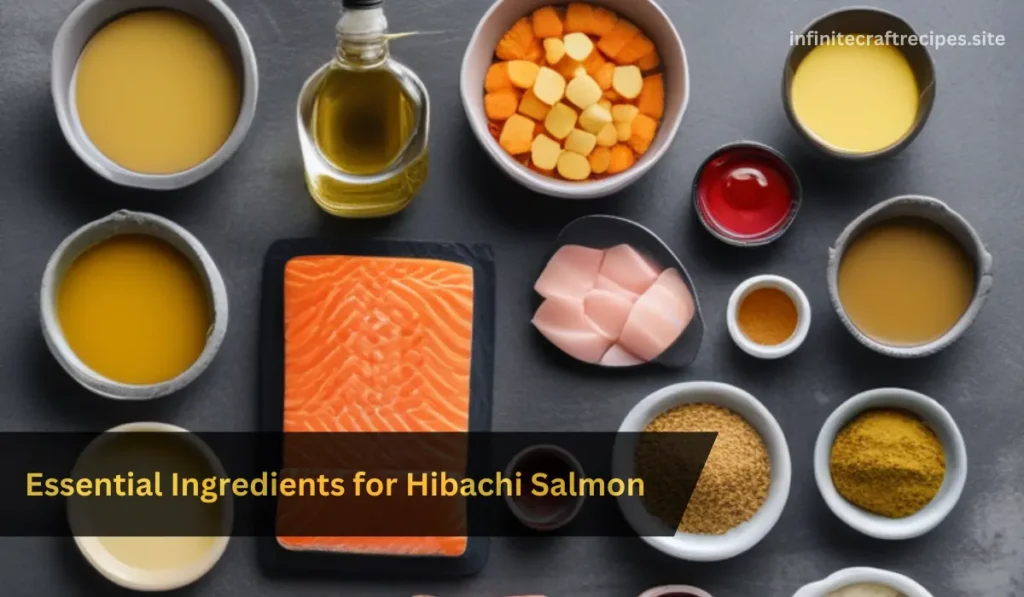
Creating delicious hibachi salmon requires a few essential ingredients. Here’s what you’ll need:
Basic Ingredients
| Ingredient | Quantity |
| Salmon Fillets | 2-3 fillets (5-6 oz each) |
| Sesame Oil | To taste |
| Extra Virgin Olive Oil | To taste |
| Minced Garlic | 1-2 cloves |
| Minced Ginger | 1 teaspoon |
| Soy Sauce | 2 tablespoons |
| Rice Vinegar | 1 tablespoon |
| Lemon Juice | Freshly squeezed |
Optional Ingredients
- Seasonings: Black pepper, honey, or chili oil can enhance the dish further.
- Garnishes: Sesame seeds or chopped green onions for presentation.
Making Hibachi Sauce
The hibachi sauce is a crucial element that elevates the dish. Here’s how to make it:
Ingredients for Hibachi Sauce
- 2 tablespoons soy sauce
- 1 tablespoon sesame oil
- 2 tablespoons rice vinegar
- 1 tablespoon honey or brown sugar
- 1 teaspoon minced garlic
- 1 teaspoon minced ginger
Instructions
- In a small bowl, whisk together all ingredients until well combined.
- Set aside until ready to use.
Preparing the Salmon
Properly preparing your salmon is essential for achieving the perfect texture and flavor.
Steps to Prepare Salmon
- Rinse and Dry: Rinse the salmon fillets under cold water and pat them dry with paper towels to remove excess moisture.
- Cutting (Optional): You can cut the fillets into bite-sized cubes or keep them whole depending on your preference.
- Seasoning: Lightly season both sides with salt and pepper.
Cooking Techniques for Hibachi Salmon
There are several methods to cook hibachi salmon effectively, whether using a grill or stovetop.
Basic Hibachi Salmon Recipe
Ingredients
- 2 salmon fillets
- 2 tbsp soy sauce
- 1 tbsp sesame oil
- 1 tbsp mirin (optional)
- 1 tsp minced garlic
- 1 tsp grated ginger
- Salt and pepper to taste
Instructions
- Preheat the Hibachi Grill: Heat your hibachi grill to medium-high heat.
- Prepare the Marinade:
- In a small bowl, combine soy sauce, sesame oil, mirin, garlic, and ginger.
- Mix thoroughly to create a flavorful marinade.
- Season the Salmon:
- Pat the salmon fillets dry.
- Season with salt and pepper, then brush generously with the marinade.
- Prepare the Grill: Lightly oil the hibachi grill grates to prevent sticking.
- Cook the Salmon:
- Place the fillets skin-side down on the grill and cook for 3–4 minutes.
- Flip the fillets and cook for another 3–4 minutes, or until the salmon is cooked through and flakes easily with a fork.
- Serve: Pair with steamed rice and grilled vegetables for a complete hibachi meal.
This recipe highlights the essence of hibachi cooking while being approachable for beginners.
Alternate Cooking Methods
Using a Grill
- Preheat the Grill: Heat your grill to medium-high (around 400°F).
- Oil the Grates: Brush vegetable oil onto the grill grates to prevent sticking.
- Sear the Salmon:
- Place the salmon fillets on the grill, skin-side down.
- Sear for about 4 minutes on one side.
- Carefully flip using tongs and cook for another 4–6 minutes until the salmon is cooked through (internal temperature should reach 145°F).
- Add the Sauce:
- Mix soy sauce, mirin, honey, garlic, and ginger in a bowl.
- Pour the sauce over the salmon during the last minute of cooking.
- Serve: Garnish with green onions and serve with lemon wedges.
Using a Stovetop
- Heat the Oils: In a non-stick skillet over medium-high heat, add sesame oil and olive oil.
- Sear the Salmon:
- Place the salmon fillets skin-side down in a single layer.
- Sear for about 4 minutes.
- Gently flip using a fish spatula and cook for another 3–4 minutes.
- Prepare the Sauce:
- Remove the salmon from the pan.
- Add minced garlic and ginger to the skillet and sauté for 30 seconds.
- Return the salmon to the pan and pour in the sauce mixture, coating the fillets.
- Serve: Sprinkle green onions on top before serving.
Both methods deliver a perfectly cooked hibachi salmon, allowing you to choose the cooking style that best suits your kitchen setup.
Plating and Presentation of Hibachi Salmon
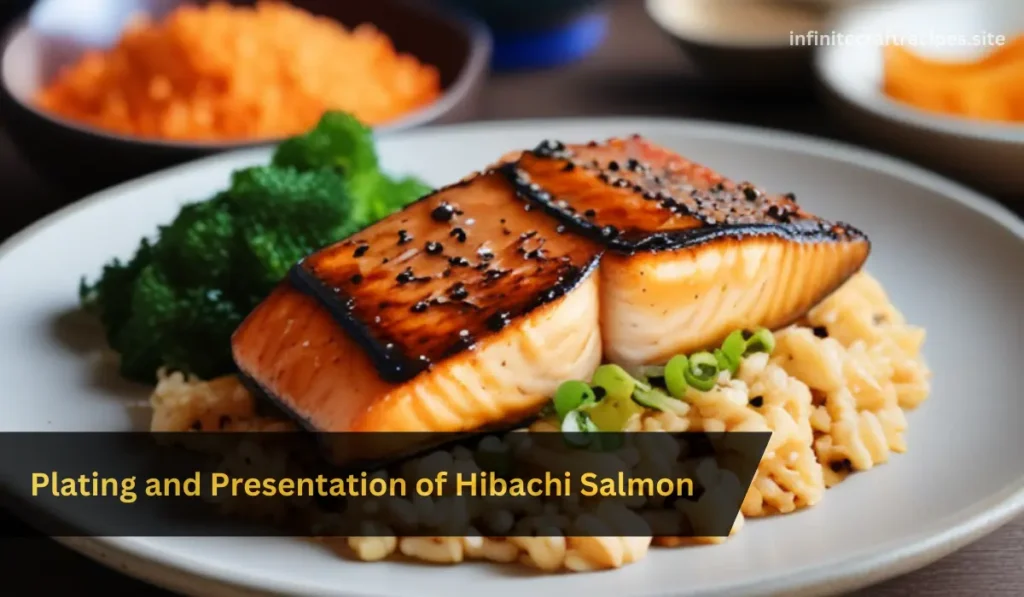
Presentation is key when serving hibachi salmon. Here are some tips:
Plating Tips
- Serve on a large platter or individual plates.
- Drizzle remaining sauce over salmon fillets.
- Garnish with sesame seeds or chopped green onions for added color.
Pairing with Sides
Hibachi salmon pairs beautifully with various sides that complement its flavors:
Recommended Sides
| Side Dish | Description |
| Hibachi Fried Rice | A classic accompaniment made with day-old rice, vegetables, and eggs. |
| Grilled Vegetables | Zucchini, bell peppers, and onions add freshness. |
| Yum Yum Sauce | A creamy dipping sauce that enhances the meal’s flavor profile. |
Recipes for Side Dishes
Hibachi Fried Rice Recipe
Ingredients:
- 2 cups cooked rice (preferably day-old)
- 1 cup mixed vegetables (peas, carrots, corn)
- 2 eggs
- 2 tablespoons soy sauce
- Green onions for garnish
- Sesame oil for cooking
Instructions:
- Heat sesame oil in a large skillet over medium heat.
- Add mixed vegetables and sauté until tender.
- Push vegetables to one side; crack eggs into the other side and scramble until cooked through.
- Add rice and soy sauce; stir-fry everything together until heated through.
- Garnish with chopped green onions before serving.
Grilled Vegetables Recipe
Ingredients:
- Assorted vegetables (zucchini, bell peppers, mushrooms)
- Olive oil
- Salt and pepper
- Sesame seeds (optional)
Instructions:
- Preheat grill or grill pan over medium heat.
- Toss vegetables in olive oil, salt, and pepper.
- Grill vegetables until tender and slightly charred (about 5–7 minutes).
- Sprinkle with sesame seeds before serving.
Storing Leftovers
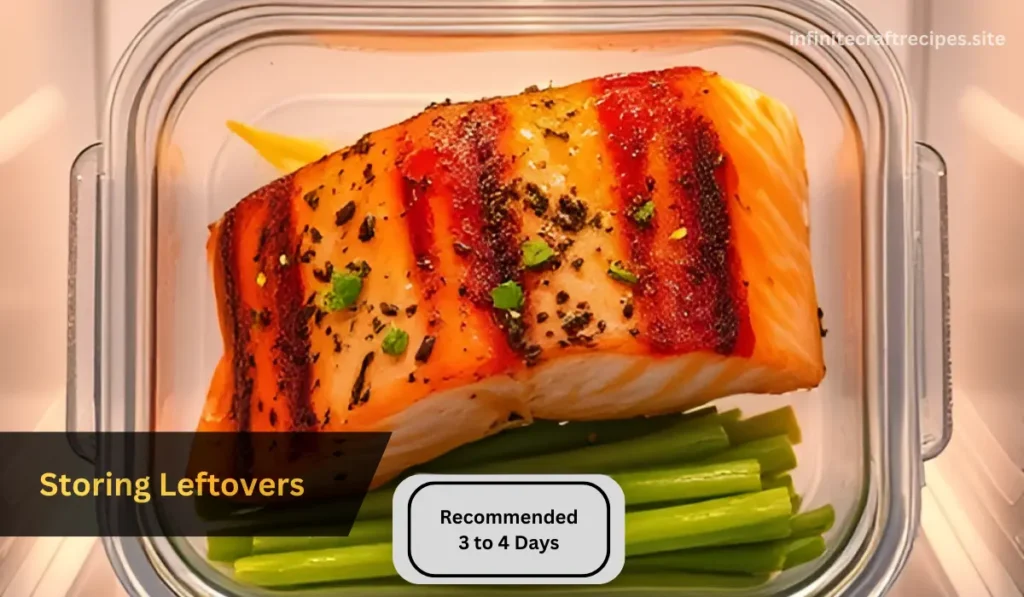
If you have any leftovers from your hibachi dinner, proper storage is essential:
Storage Tips
- Allow cooked salmon to cool completely before storing.
- Place in an airtight container in the refrigerator; it will last up to 3 days.
- Reheat gently in the microwave or on low heat in a skillet to avoid drying out.
Common Mistakes to Avoid
To ensure your hibachi salmon turns out perfectly every time, here are some common mistakes to watch out for:
| Mistake | Description |
| Overcooking | Keep an eye on cooking times; remove from heat while still slightly pink inside as it will continue cooking off heat. |
| Skipping Seasoning | Don’t skip seasoning; even simple salt and pepper can enhance flavors significantly. |
| Using Low-quality Ingredients | Freshness matters—opt for high-quality fish and ingredients whenever possible. |
Health Benefits of Salmon
In addition to its delicious taste, salmon offers numerous health benefits:
Nutritional Advantages
Salmon is not only tasty but also packed with nutrients that can benefit your health:
- Rich in Omega-3 Fatty Acids: These healthy fats are known to promote heart health by reducing inflammation and lowering blood pressure.
- High in Protein: Salmon provides high-quality protein necessary for muscle growth and repair.
- Vitamins & Minerals: It is an excellent source of essential vitamins like vitamin D (important for bone health) and B vitamins (crucial for energy metabolism).
Variations on Hibachi Salmon
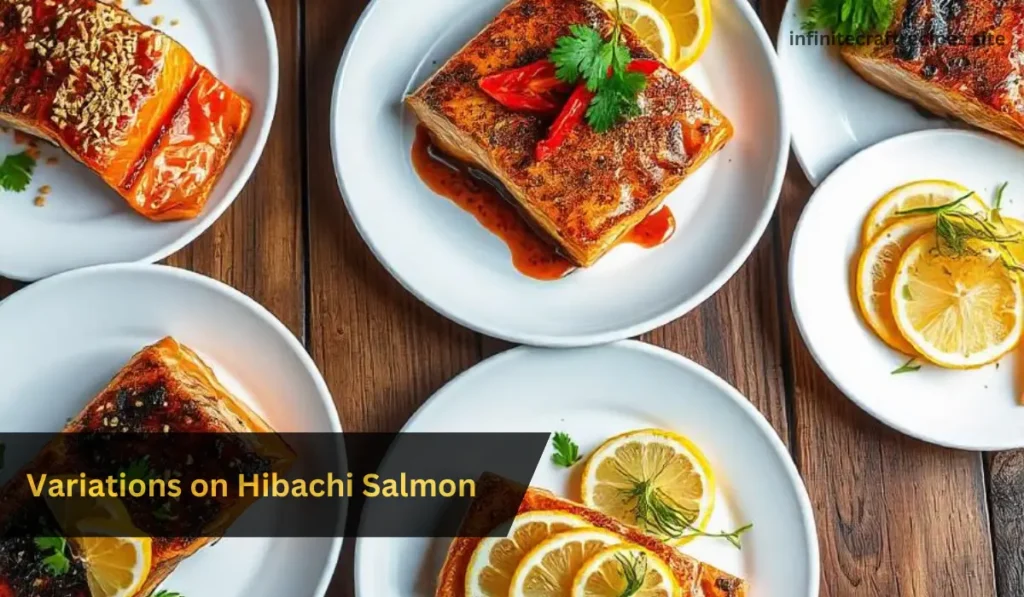
Hibachi salmon is a versatile dish that can be customized in numerous ways to suit different tastes and preferences. Here are some exciting variations to try, each bringing its unique flair to this beloved dish:
1. Teriyaki Glazed Hibachi Salmon
For those who enjoy a sweeter flavor profile, try glazing your hibachi salmon with a homemade teriyaki sauce. Combine soy sauce, mirin, brown sugar, and ginger in a saucepan and simmer until thickened. Brush this glaze over the salmon during the last few minutes of cooking for a deliciously sticky finish that pairs beautifully with steamed rice and vegetables.
Ingredients:
- 4 salmon fillets
- 1/2 cup soy sauce
- 1/4 cup mirin
- 2 tbsp brown sugar
- 1 tbsp grated ginger
- Steamed rice (for serving)
- Vegetables (for serving)
Instructions:
- In a saucepan, combine soy sauce, mirin, brown sugar, and grated ginger.
- Simmer over medium heat for about 5-7 minutes until the sauce thickens slightly.
- Preheat the grill or hibachi grill to medium-high heat.
- Brush the salmon fillets with the teriyaki glaze.
- Grill the salmon for 4-5 minutes per side, brushing more glaze over the fillets as they cook.
- Serve the salmon with steamed rice and grilled vegetables for a complete dish.
2. Spicy Gochujang Hibachi Salmon
If you prefer a kick of heat, consider using gochujang, a Korean chili paste, to spice things up. Mix gochujang with soy sauce, sesame oil, and honey for a spicy-sweet marinade. Marinate the salmon for at least 30 minutes before cooking. This variation adds depth and complexity to the dish, making it perfect for spice lovers.
Ingredients:
- 4 salmon fillets
- 2 tbsp gochujang (Korean chili paste)
- 2 tbsp soy sauce
- 1 tbsp sesame oil
- 1 tbsp honey
- Fresh herbs (for garnish)
Instructions:
- In a bowl, mix gochujang, soy sauce, sesame oil, and honey until combined.
- Marinate the salmon fillets in the mixture for at least 30 minutes.
- Preheat your hibachi grill to medium-high heat.
- Grill the salmon for 4-5 minutes on each side, basting with the marinade as it cooks.
- Garnish with fresh herbs and serve.
3. Lemon Herb Hibachi Salmon
For a lighter option, try infusing your hibachi salmon with fresh herbs and citrus. Create a marinade using olive oil, lemon juice, minced garlic, and chopped fresh herbs like dill or parsley. Marinate the salmon for about 20 minutes before grilling. The result is a refreshing dish that highlights the natural flavors of the fish.
Ingredients:
- 4 salmon fillets
- 2 tbsp olive oil
- Juice and zest of 1 lemon
- 2 cloves garlic, minced
- 1/4 cup chopped fresh dill or parsley
- Salt and pepper to taste
Instructions:
- In a bowl, mix olive oil, lemon juice, lemon zest, minced garlic, chopped herbs, salt, and pepper.
- Marinate the salmon fillets for about 20 minutes.
- Preheat the hibachi grill to medium-high heat.
- Grill the salmon for 4-5 minutes per side, brushing with the marinade during grilling.
- Serve with a side of steamed vegetables or rice.
4. Miso-Glazed Hibachi Salmon
Miso paste can elevate your hibachi salmon to new heights with its umami-rich flavor. Combine miso paste with rice vinegar, honey, and sesame oil to create a savory glaze. Brush this mixture over the salmon while it cooks for a rich and flavorful finish that pairs well with grilled vegetables.
Ingredients:
- 4 salmon fillets
- 3 tbsp miso paste
- 2 tbsp rice vinegar
- 1 tbsp honey
- 1 tbsp sesame oil
- Steamed vegetables (for serving)
Instructions:
- In a bowl, whisk together miso paste, rice vinegar, honey, and sesame oil.
- Preheat your hibachi grill to medium-high heat.
- Brush the miso glaze over the salmon fillets.
- Grill the salmon for 4-5 minutes per side, brushing more glaze on the fillets as they cook.
- Serve the miso-glazed salmon with steamed vegetables for a well-balanced meal.
5. Citrus Soy Marinade
Combine the zest and juice of oranges and limes with soy sauce and garlic for a vibrant marinade that brightens the dish. Allow the salmon to marinate for at least an hour before grilling to infuse it with zesty flavors. This variation not only enhances the taste but also adds a beautiful color contrast when served.
Ingredients:
- 4 salmon fillets
- Zest and juice of 1 orange
- Zest and juice of 1 lime
- 3 tbsp soy sauce
- 2 cloves garlic, minced
Instructions:
- In a bowl, combine orange zest, lime zest, orange juice, lime juice, soy sauce, and minced garlic.
- Marinate the salmon for at least 1 hour in the citrus-soy mixture.
- Preheat the hibachi grill to medium-high heat.
- Grill the salmon for 4-5 minutes per side, basting with the marinade during grilling.
- Serve with a garnish of citrus slices and steamed rice or vegetables.
These recipes will give your hibachi salmon various flavor profiles to suit different tastes, from sweet to spicy to light and zesty!
Hibachi Cooking Equipment
Having the right equipment can enhance your hibachi cooking experience:
Essential Tools
- Grill or Griddle Pan: A flat surface allows even cooking; consider using cast iron or non-stick options.
- Spatula & Tongs: For flipping and serving without damaging delicate fish fillets.
Hosting a Hibachi Dinner Party
Hosting a hibachi dinner party can be an enjoyable experience for both you and your guests:
Tips for Hosting
- Set up your cooking area where guests can see you prepare their meals.
- Prepare all ingredients beforehand to streamline cooking during dinner service.
- Engage guests by allowing them to choose their preferred level of doneness or sauces.
Exploring Hibachi Culture
Understanding the cultural aspects of hibachi dining can enrich your culinary experience:
Fun Fact: The Origins of Hibachi Cooking
Did you know?
The term “hibachi” actually refers to a traditional Japanese heating device. Originally, it was a portable grill used for cooking over an open flame, often made from a ceramic bowl filled with charcoal. While today’s hibachi restaurants feature large flat-top grills where chefs perform impressive culinary feats, the essence of hibachi cooking remains rooted in the art of grilling and sharing delicious food with loved ones. So, the next time you enjoy hibachi salmon, remember that you’re partaking in a centuries-old tradition that celebrates both flavor and community!
Cultural Insights
Hibachi dining is more than just food; it’s about community:
- Traditionally served in Japanese steakhouses where chefs perform tricks while cooking.
- Emphasizes communal dining—often enjoyed with family or friends at large tables.
FAQs about Hibachi Salmon
Here are some frequently asked questions about hibachi salmon:
What is hibachi-style cooking?
Hibachi-style cooking involves grilling food at high temperatures on a flat surface, often accompanied by theatrical preparation by chefs in front of diners.
Can I use other types of fish besides salmon?
Yes! Firm fish like steelhead trout or halibut can also be excellent alternatives in this recipe.
How do I know when my hibachi salmon is cooked?
Salmon should be cooked until it flakes easily with a fork; an internal temperature of 145°F indicates it’s done.
What should I serve with my hibachi salmon?
Common pairings include fried rice, grilled vegetables, or even a light salad dressed with citrus vinaigrette.
How do I store leftover hibachi salmon?
Store leftovers in an airtight container in the refrigerator; they will keep well for up to three days.
What is the origin of hibachi?
The term “hibachi” refers originally to a portable heating device used in Japan; today it describes both cooking style and dining experience popularized by Japanese steakhouses.
Can I make this recipe gluten-free?
Absolutely! Use tamari instead of soy sauce to make this dish gluten-free without sacrificing flavor.
Conclusion
In conclusion, mastering hibachi salmon not only allows you to enjoy this delicious dish but also brings an exciting culinary experience into your home kitchen. By selecting fresh ingredients, perfecting your techniques, and embracing creativity through variations, you can create memorable meals that impress family and friends alike. For more delicious recipes like this one visit Infinite Craft Recipes, where we share an array of flavorful dishes that will inspire your culinary journey! Whether you’re looking for quick weeknight dinners or elaborate weekend feasts, our collection has something special waiting just for you!
Ready to Master Hibachi Salmon?
Now that you’ve learned all about hibachi salmon and the art of cooking it, why not try your hand at this flavorful dish? Gather your ingredients, fire up your grill or stovetop, and impress your family and friends with your newfound skills! If you enjoyed this guide, be sure to share your hibachi salmon creations on social media and tag us! Don’t forget to check out our other recipes on Infinite Craft Recipes for more delicious meal ideas. Happy cooking!


